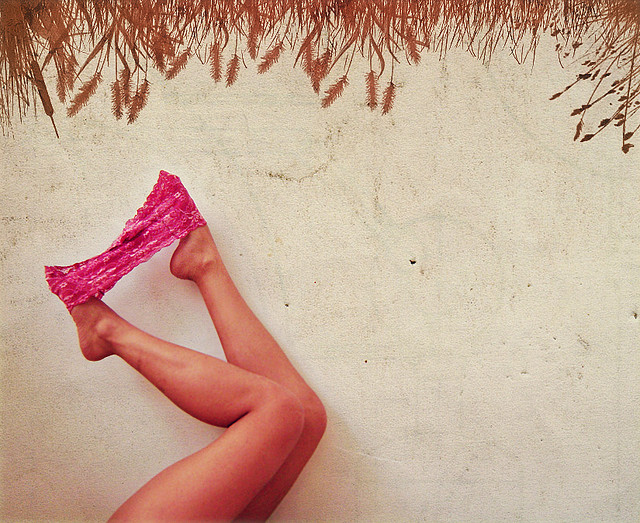
Dear Lady Friends,
I’ve been you: looking down at my panties while using the bathroom, feeling a mix of both disgust and dismay at the snail trail in my underwear. Like you, I’ve wondered what on earth was happening in my nether regions to create what looked like day-old rubber cement in my skivvies. I remember thinking that surely I was the only woman in history to experience this mysterious occurrence, and it wasn’t until I was in my early 20s that my best friend Terra confided that she, too, had something a little freaky happening down south.
What a relief to know it wasn’t just me. Thankful to finally be able to talk openly about it with someone, Terra and I cataloged our vaginal secretions: from crumbly to slimy and everything in between. And the fact that it changed from week to week—sometimes even day to day. We felt better knowing that it was apparently normal, but we still didn’t have the first clue as to why it was happening.
It wasn’t until I was 30 years old, actively trying to get pregnant, that I would get to the bottom of what was going on down there. It was then that I read Toni Wechsler’s book, Taking Charge of Your Fertility which is essentially the user’s guide to female reproductive system. From Toni, I learned that our vaginal secretions are in fact incredibly functional, a result of the intricate dance of our female hormones.
Discovering the relatively simple answer to my years of wondering was enlightening and liberating, for sure, but it was also kind of infuriating. How could I have been in the dark for so many years about my own body? The simple answer, of course, is that all of the women in my life were also in the dark about their own bodies. There was no one to teach me about vaginal secretions as a teen or young woman because no one else knew what it was either. Isn’t it crazy to think that despite the enormous and nearly miraculous medical advancements of the past 100 years, we women of the 21st century are still largely clueless about our own vaginas?
So when I saw the #cleanpantychallenge trending, I couldn’t help but feel both sad and frustrated.
Unlike some recently popular challenges such as the Ice Bucket Challenge, the Clean Panty Challenge was not created to raise funds and awareness for a worthwhile cause, but was based on a derogatory and divisive—and yes, completely ill-informed—video posted on Facebook. The vlogger claims that she has perfectly spotless underwear thanks to the fact that she “drinks a lot of water” and knows “how to wipe.” The video went viral and compelled a slew of hashtagged underwear snaps, which is somewhat disturbing in itself, because ew.
But that wasn’t what really troubled me. The deeper issue with the Clean Panty Challenge is how perfectly it illuminates our general lack of understanding about our own wise female bodies. This complete disconnect has allowed us to buy into the damaging cultural narrative that our bodies are disgusting, gross, dysfunctional, and most of all, something to feel ashamed of. And that really pisses me off.
But like I said, I’ve been there. And I want to share with you the five things I wish I’d known then about vaginal discharge:
1. It’s Completely Normal.
Vaginal discharge isn’t the result of not drinking enough water or not having good hygiene. There’s nothing you did or didn’t do to create discharge. It’s a perfectly natural bodily function just like digesting, breathing or ovulating.
2. It Changes throughout the Month.
One day it’s dry and crumbly, another day it looks like someone spilled a bottle of rubber cement in your panties. You can thank your hormones for that. As you progress through your menstrual cycle, your female hormones (estrogen and progesterone) rise and fall, and your vaginal discharge changes along with those fluctuations.
After the first phase of your cycle, menstruation, your vaginal secretions can be dry and pasty while your estrogen and progesterone levels are at their lowest. During the second week of your cycle, estrogen rises as you prepare to ovulate, and your vaginal discharge is likely to be more wet or creamy. Moving toward the mid-point of your cycle, around day 10 or 11, you will begin to see the thicker, stretchier “egg white” vaginal discharge. Just before you ovulate, which typically happens around day 14, your estrogen levels reach their peak and your vaginal discharge will become slippery and wet.
Following ovulation, estrogen levels fall as progesterone continues to slowly increase, and your vaginal secretions may be watery, dry or even completely absent. During the last week of your cycle, your premenstrual week, estrogen and progesterone both decline, and you may notice that you have no discharge at all. Just before your period starts again, you may see spots of brown blood; this is simply the remnants of your previous cycle, shedding from your uterus as your body begins to prepare for menstruation once again.
3. It has a Specific Job.
As you may have noticed, the changes in our secretions basically revolve around ovulation. The primary purpose of discharge is in fact to facilitate conception. The dry, crumbly discharge we experience after our periods is a lot like a no trespassing sign for our vagina, not giving any wayward sperm much a of chance to travel up toward our uterus when there won’t be an egg ready and waiting. As we get closer to ovulation, our vaginal secretions change to a more hospitable consistency, welcoming sperm and giving them a comfortable space to hang out in preparation for the release of the egg. And then just before ovulation, we essentially roll out the red carpet for the little swimmers, giving them the best possible consistency for their long journey to the uterus. After ovulation? Without a fertility-related purpose, the vagina just can’t really be bothered.
4. It’s part of the Self-Cleaning Function of the Vagina.
Much like an oven, the vagina doesn’t need harsh chemicals to stay clean. Thanks to vaginal discharge, our interior landscape stays healthy and balanced. Flushing out bacteria and debris, and maintaining the perfect pH throughout our cycle, our discharge is all we need to stay clean throughout the month. Using commercial “hygiene” products such as douches or deodorant sprays can actually do more harm than good, altering our natural balance and introducing toxins into our sensitive lady areas.
5. It’s a way to Stay in Tune with Our Body.
With years of discharge savvy under my belt now, I use my wisdom about my normal fluctuations to keep me in tune with what’s happening downtown. Discharge that’s white, creamy, crumbly, slimy, or slippery? All good. Discharge that’s yellowish, greenish, foul-smelling, or accompanied with pain or burning? Something’s up. Keeping track of your discharge and learning what’s normal for you is just another powerful way of taking care of yourself.
So my lovely ladies, let’s send the #cleanpantychallenge the way of belted menstrual pad: to the pages of history. Rather than shame our sisters and daughters about this perfectly normal female experience, let’s empower them. Rather than perpetuate ignorance about our bodies, let’s educate one another. Rather than take up a challenge that’s based in fallacy and humiliation, let’s challenge ourselves and the women in our lives to be fully embodied and powerfully female.
~
A few powerful, inspiring women:
BONUS: Enlighten your sex life:
˜
Relephant:
If You Need Permission to Rest, Here it is. {Poem}
~
Author: Amy Bammel Wilding
Image: flickr/Helga Webber
Editor: Ashleigh Hitchcock; Lindsey Block


Read 25 comments and reply